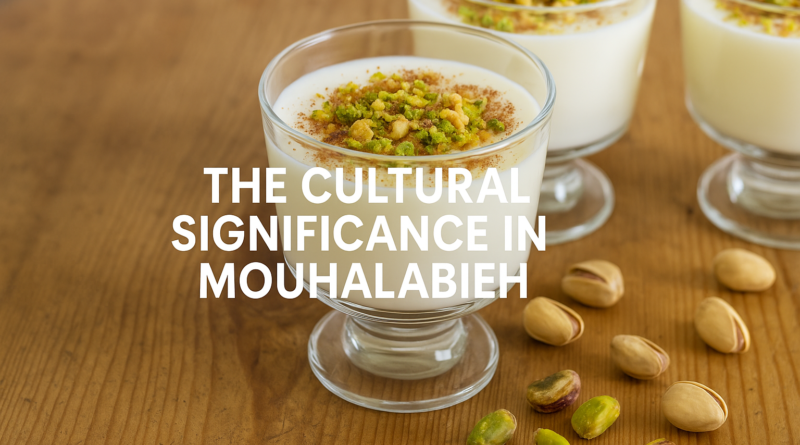The Cultural Significance in Mouhalabieh
Mouhalabieh, a delicate milk pudding, holds more than just culinary value—it is a rich cultural artifact. In this article, we will explore The Cultural Significance in Mouhalabieh through its history, traditional relevance, symbolism, and its place in contemporary society.
A Sweet Tradition Rooted in History
The Cultural Significance in Mouhalabieh begins with its origin, believed to date back to the Abbasid Caliphate. This dessert traveled across the Levant and Middle Eastern regions, bringing people together at family dinners, religious festivals, and community gatherings.
Mouhalabieh is often served during Ramadan and Eid, emphasizing togetherness and sharing. Its soft texture and subtle rose water aroma connect deeply with memories of heritage.
Ingredients with Meaning
The Cultural Significance in Mouhalabieh extends to its ingredients—milk, sugar, cornstarch, rose water, and pistachios—each representing comfort, hospitality, and tradition. Rose water symbolizes purity and spirituality, linking Mouhalabieh to ceremonial and festive occasions.
Rituals and Celebrations
In Arab culture, The Cultural Significance in Mouhalabieh includes how it is incorporated into life events. It is a favorite at weddings, family reunions, and baby showers. In these moments, the dessert symbolizes warmth, affection, and celebration of life.
Family Recipes Passed Through Generations
Many families keep their Mouhalabieh recipe a cherished secret. Some add a dash of orange blossom water or coconut flakes. This personalized touch adds emotional value and makes each version of Mouhalabieh a family treasure.
Regional Variations
While the core of Mouhalabieh remains the same, regions add their twist. In Lebanon, it’s slightly firmer. In Turkey, it may be topped with shredded coconut. This versatility reflects the widespread Cultural Significance in Mouhalabieh and its ability to adapt without losing its soul.
Mouhalabieh in Modern Culture
Today, this traditional dessert is reinvented in gourmet restaurants, often fused with modern elements like fruit coulis or caramelized nuts. This shows The Cultural Significance in Mouhalabieh is still relevant, serving as a bridge between the old and the new.
Nutrition and Comfort
Apart from cultural value, Mouhalabieh is also praised for being light and healthy. It is often recommended for people seeking gentle comfort food, making it both a physical and emotional remedy.
| Ingredient | Cultural Significance | Symbolism |
|---|---|---|
| Milk | Core of the dessert | Nurture, Comfort |
| Rose Water | Traditional flavor enhancer | Purity, Celebration |
| Cornstarch | Thickener | Simplicity, Tradition |
| Pistachios | Garnish | Abundance, Hospitality |
A Dessert with a Story
Each bowl of Mouhalabieh tells a story—of mothers and grandmothers stirring the pot, of children waiting eagerly, and of joyful gatherings. The Cultural Significance in Mouhalabieh is lived in these quiet, tender moments.
Why Mouhalabieh Matters
The reason behind the timeless love for this dessert lies in its simplicity and emotional resonance. In a world that changes fast, Mouhalabieh remains a comforting constant. Its very presence on the table becomes a reminder of home, belonging, and love.
Preserving Tradition in a Changing World
With globalization, many traditional dishes fade away. But The Cultural Significance in Mouhalabieh continues because of efforts to pass down recipes, feature it in cookbooks, and include it in modern culinary education.
FQA (Frequently Questioned Answers)
What does Mouhalabieh represent in Arab culture?
Mouhalabieh represents family, hospitality, and tradition. It is served during major life events and festive occasions.
Is Mouhalabieh served on specific holidays?
Yes, it’s especially popular during Ramadan and Eid, symbolizing sharing and celebration.
How is Mouhalabieh different across regions?
Some regions prefer it firmer, others garnish it differently. The essence remains, but cultural nuances make it unique.
Why is rose water used in Mouhalabieh?
Rose water adds a traditional floral note that symbolizes purity and festivity, making it culturally rich.
Can Mouhalabieh be part of modern cuisine?
Absolutely. Chefs are reinventing it with modern presentations while keeping its cultural essence intact.
What makes Mouhalabieh emotionally significant?
It is tied to memories of home, family, and tradition, creating deep emotional bonds.
Is Mouhalabieh healthy?
Yes, it’s often seen as a light and soothing dessert, suitable for various diets.
How can I make Mouhalabieh at home?
The basic recipe includes milk, sugar, cornstarch, and rose water. Garnish with pistachios for a traditional touch.
Why is Mouhalabieh still relevant today?
Its timeless flavor, emotional connection, and cultural richness keep it relevant across generations.
Can Mouhalabieh be vegan?
Yes, using plant-based milk and a natural sweetener can make it vegan-friendly without losing its essence.
Final Thoughts
The Cultural Significance in Mouhalabieh is not just in its taste but in the emotions and traditions it evokes. It connects generations, tells stories, and celebrates life through its subtle sweetness and humble ingredients. As long as people gather around tables to share love, Mouhalabieh will continue to play its part in culture and memory

